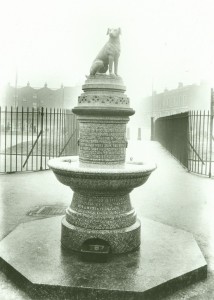It can be surprising to discover that the largest, most controversial and violent riot in Britain concerning the emotive issue of animal rights occurred not in recent years, but in 1907. And the most vociferous and heated protagonists were not those demonstrating on behalf of animals, but medical students defending their barbaric and unregulated scientific experiments. The so-called Brown Dog Affair raged for seven years – culminating in a night of violent rioting exactly 110 years ago – and would prove to be one of Edwardian London’s most divisive issues.
The drama began in December 1902, when two female anti-vivisectionists from Sweden infiltrated the medical school at University College London and bore witness to the cruelty perpetrated against one particular brown terrier. During a lecture, a professor cut open the abdomen of the insufficiently anaesthetised animal in order to deprive the dog of the use of its pancreas. For the next two months, the terrier was confined to a cage where his miserable howling upset several UCL staff, until he was brought back to the lecture theatre in February 1903. Stretched on his back on an operating table, the dog’s legs and head were clamped and his mouth muzzled before he was once again cut open to inspect the results of the experiment. He was then handed over to another professor who cut a new opening, then stimulated with electricity in an attempt to prove that salivary pressure was independent of blood pressure. After half-an-hour of unimaginable agony for the dog, the experiment was deemed a failure and abandoned. The terrier was given over to a student who removed the pancreas before finally relieving the poor animal of its torture with a fatal slit to the throat.
When the Swedish women exposed the inhumane and prolonged suffering of this unfortunate unnamed dog, the researchers of UCL sued for libel – claiming that they were within the law. They won the court battle, but lost the war of public opinion – and the brown dog became a cause célèbre. In 1906, a memorial statue to the tragic terrier was erected in Latchmere Park, Battersea:
“In Memory of the Brown Terrier Dog Done to Death in the Laboratories of University College in February 1903 after having endured Vivisections extending over more than two months and having been handed over from one Vivisector to another till Death came to his release. Also in memory of the 232 dogs vivisected in the same place during the year 1902. Men and Women of England – How long shall these things be?”
The statue – with its bold and brazen anti-vivisectionist inscription – became a symbolic rallying point for political activists. But scientists, doctors and medical students loathed the provocative bronze dog for the scorn it poured over their profession. When legal efforts to remove the statue failed, these “anti-doggers” repeatedly tried to destroy it themselves, forcing the progressive council of Battersea to employ 24-hour protection.
The Brown Dog debate raged on the streets, at public meetings, in the newspapers and in Parliament. In a demonstration planned to coincide with the annual Oxford-Cambridge rugby match on December 10th 1907, medical students from UCL – joined by their Oxford and Cambridge peers – once again attempted to uproot the statue with a sledgehammer. Driven away by locals, the students marched towards Trafalgar Square and sang to the tune of “Little Brown Jug”:
As we go walking after dark,
We turn our steps to Latchmere Park,
And there we see, to our surprise,
A little brown dog that stands and lies.
Ha, ha, ha! Hee, hee, hee!
Little brown dog how we hate thee.
As over 1000 rowdy anti-doggers gathered around Nelson’s Column, mounted police charged the crowd and arrested the ringleaders – including one Cambridge undergraduate “barking like a dog.” Over the following days and weeks, more rioting broke out. Animal lovers were identified and subjected to abuse by gangs of marauding anti-doggers. Trade union and women’s suffrage meetings were routinely invaded by medical students, barking and shouting “Down with the Brown Dog!” The matter was not resolved until March 10th, 1910 – when the new local council, unwilling to pay the mounting security costs, removed the statue in the dead of night.
The Brown Dog Riots were instigated by elitists, not only by position of their class, but in their misguided and quasi-religious belief that science was entitled to its own exclusive code of ethics. Can the quest for knowledge ever justify barbaric inhumanity? Over a century later, the repugnant and unnecessary practice of vivisection – torture by any other name – still continues.
Men and Women of England – How long shall these things be? As Mahatma Ghandi said, “The greatness of a nation and its moral progress can be judged by the way its animals are treated.”



6 Responses to 10th December 1907 – The Brown Dog Riots